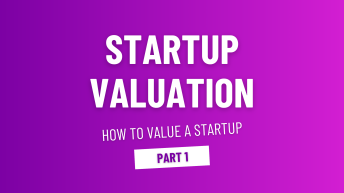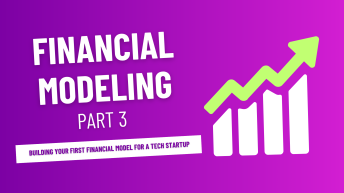1. Bootstrapping
The process of building a startup with minimal external funding, relying on personal savings, operational revenues, and cost-saving strategies to grow the business.
2. Pitch Deck
A presentation created by startups to showcase their business idea, strategy, and potential to investors. It includes information on the product, market opportunity, financials, and team.
3. Financial Modeling
The process of creating a financial representation of a business, projecting its future revenues, costs, and cash flow based on key assumptions.
4. Accelerator
A fixed-term, cohort-based program that provides startups with mentorship, funding, and resources to rapidly grow their business. Accelerators usually culminate in a “demo day” where startups pitch to investors.
5. Angel Investor
An individual who provides capital to early-stage startups, typically in exchange for equity. Angel investors are often the first external investors in a startup.
6. Venture Capital (VC)
A form of private equity financing provided by VC firms or investors to startups and early-stage companies with high growth potential, in exchange for equity.
7. Seed Funding
The initial capital raised by a startup, often from angel investors or seed funds, to validate the idea and build a minimum viable product (MVP).
8. Convertible Note
A short-term debt that converts into equity, typically in conjunction with a future financing round, allowing early investors to receive stock instead of repayment.
9. Cap Table
A table that outlines the ownership stakes in a company, showing the percentages held by founders, investors, and other shareholders.
10. Valuation
The process of determining the current or projected worth of a company, based on factors like revenue, assets, market opportunity, and growth potential.
11. Due Diligence
The process by which potential investors investigate a startup’s business, financials, legal structure, and market potential before committing capital.
12. Term Sheet
A non-binding agreement that outlines the terms and conditions under which an investment will be made, including valuation, equity split, and investor rights.
13. Lead Investor
The investor who takes the lead role in a funding round, negotiating terms and coordinating with other investors.
14. VC Firm
A company that manages funds provided by Limited Partners (LPs) to invest in high-growth startups, often taking equity stakes and providing operational guidance.
15. Equity Financing
The process of raising capital by selling ownership shares (equity) in a company to investors, often in exchange for funding.
16. Venture Debt
A type of loan offered to startups, often in combination with equity financing, used as a way to raise capital without giving up additional equity.
17. Series A
The first significant round of venture capital financing, typically raised after seed funding, used to scale the company’s product, team, and operations.
18. Series B
A later stage of venture capital funding that helps a startup expand its reach, further develop its product, and increase its customer base.
19. Series C
A funding round usually raised to scale operations on a larger level, often to prepare for an acquisition, IPO, or other significant liquidity event.
20. Preferred Stock
A class of ownership in a company that provides certain privileges, such as priority on dividends and liquidation, over common stockholders.
21. Common Stock
The standard equity ownership in a company, typically held by founders and employees, which carries voting rights but is subordinate to preferred stock in terms of dividends and liquidation.
22. Dilution
The reduction of ownership percentage when a company issues new shares during funding rounds, decreasing the proportion of equity held by existing shareholders.
23. Burn Rate
The rate at which a startup spends its cash reserves to cover operating expenses before becoming cash flow positive.
24. Runway
The amount of time a company has before it runs out of cash, based on its current burn rate.
25. Bridge Financing
A short-term funding round designed to extend a company’s runway until it can raise a larger round of investment, often in the form of convertible debt.
26. Follow-On Investment
Additional investment made by existing investors in subsequent funding rounds, typically to maintain or increase their equity stake in the company.
27. Exit Strategy
A plan for how investors or founders will realize returns on their investment, often through an acquisition, merger, or initial public offering (IPO).
28. Liquidity Event
A significant event, such as an acquisition or IPO, that allows shareholders to sell their equity holdings for cash or other assets.
29. Exit Multiple
A metric used to evaluate the value of a company at exit (e.g., acquisition or IPO), often calculated by comparing the exit price to earnings, revenue, or other financial metrics.
30. Initial Public Offering (IPO)
The process of offering shares of a private company to the public for the first time, often marking a major milestone for a startup’s growth and providing liquidity for investors.
31. Management Fee
The annual fee charged by venture capital firms to their Limited Partners (LPs), typically a percentage of the total fund size, to cover operational costs of managing the fund.
32. Carried Interest
The share of the profits that venture capital firms receive as compensation, typically after the LPs have received a return on their invested capital.
33. Limited Partner (LP)
An investor in a venture capital fund who provides capital but typically does not participate in day-to-day management of the fund.
34. General Partner (GP)
The individual(s) who manage a venture capital fund, make investment decisions, and are responsible for the fund’s performance, often receiving carried interest as compensation.
35. Portfolio Company
A startup or business that has received investment from a venture capital firm, making it part of that firm’s portfolio of companies.
36. Fund of Funds
An investment strategy where a venture capital firm or other institutional investor invests in other VC funds rather than directly in startups, allowing for broader exposure to startups.
🚀 Ready to fuel your startup’s growth? Join multiples.cc today! Gain access to valuable tools, connect with investors, and get personalized support to help you succeed on your fundraising journey. Sign up now and take the next step toward securing the resources your startup needs to thrive!






Add comment